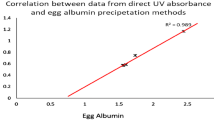Abstract
Present study extended the list of solvent and reagents appropriate to use for the colorimetric detection and semi quantitative analysis of various energetic compounds. The new reagents used in this study include DMSO as solvent/reagent, and tetramethylammonium hydroxide and tetrabutylammonium hydroxide for the generation of a basic medium. The advantages of these reagents vs. older procedures are discussed in this paper. Also, a standardized procedure for the analysis of several classes of energetic compounds has been developed, allowing an excellent practical application of the recommended method. The influence of different solvents on the changes in the UV/VIS spectra were evaluated and an attempt to interpret the resulting absorption UV spectra based on quantum-chemical calculations has been done.
Similar content being viewed by others
References
J. Yinon and S. Zitrin, The Analysis of Explosives, Pergamon Series in Analytical Chemistry, Vol. 3 (Pergamon Press, New York, 1981).
A. Beveridge, J. Energ. Mater. 4, 29–75 (1986).
T. Urbanski, Chemistry and Technology of Explosives, Vol. 3 (Pergamon Press, Oxford, 1965).
B. Glattstein, Eur. Patent Application, 0 264 252 A2, Int. Cl. G 01 N 31/22 (1988).
D. S. Moore, Sens. Imaging (2007), pp. 8: 9–38.
A. Hilmi, J. H. T. Luong, and An-Lac Nguyen, J. Chromatogr. A 844, 97–110 (1999).
A. B. Crockett, H. D. Craig, and F. F. Jenkins, EPA/600/S-99/002 (May 19, 1999).
F. Feigl, Spot Tests, Vol. II: Organic Applications (Elsevier, Amsterdam, Houston, London, New York, 1954).
D. De Tata, P. Collins, and N. Campbell, J. Forensic Sci. 51, 303–307 (2006).
T. F. Jenkins, P.W. Schumacher, J. G. Mason, and P. G. Thorne, Special Report 96-10 (US Army Corps of Engineers, Cold Regions Res. Eng. Lab., 1996)
M. M. Quasim, B. Moore, L. Taylor, P. Honea, L. Gorb, and J. Leszcznsky, Int. J. Mol. Sci. 8, 1234–1264 (2007).
J. B. Fox, Jr. Anal. Chem. 51, 1493–1502 (1979).
T. F. Jenkins, D. C. Leggett, C. L. Grant, and C. F. Bauer, Anal. Chem. 58, 171–175 (1986).
J. Fries and H. Getrost, Organic Reagents for Trace Analysis (E. Merck, Darmstadt, 1977).
J. J. P. Stewart, J. Comp.-Aided Mol. Design 4(Spec. Iss.), 1–105 (1990)
J. J. P. Stewart, MOPAC-7, QCPE 113 (Indiana Univ., Bloomington, 1994).
S. C. Moldoveanu, Unpublished Results.
Author information
Authors and Affiliations
Corresponding author
Additional information
The article is published in the original.
Rights and permissions
About this article
Cite this article
Dimitriu, E., Moldoveanu, S.C. & Iorgulescu, E.E. Solvent-reagent effect in chemical detection of energetic materials type contaminants. Russ. J. Phys. Chem. 83, 1537–1541 (2009). https://doi.org/10.1134/S0036024409090210
Published:
Issue Date:
DOI: https://doi.org/10.1134/S0036024409090210




